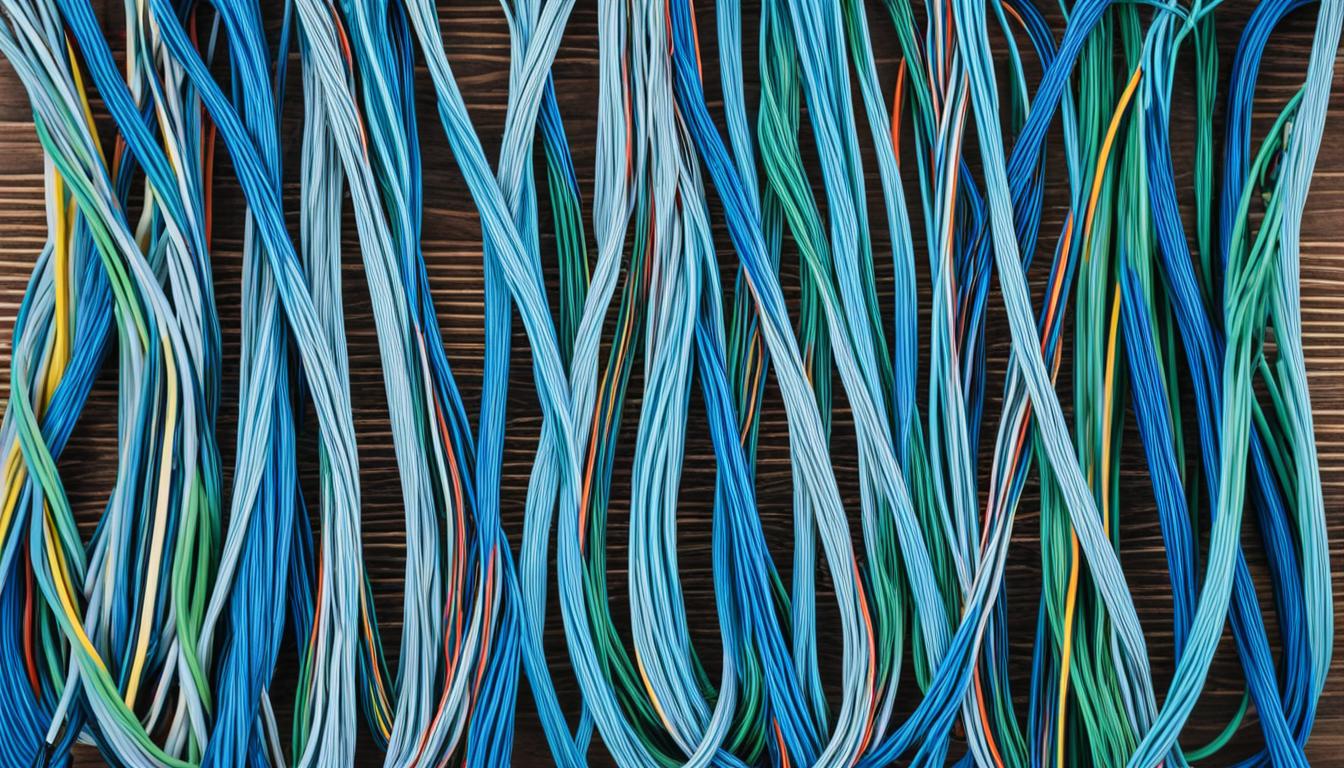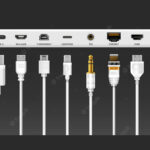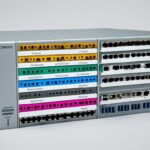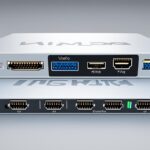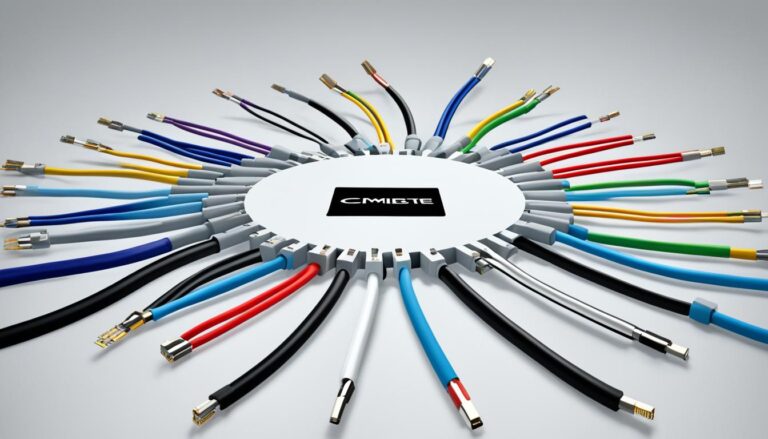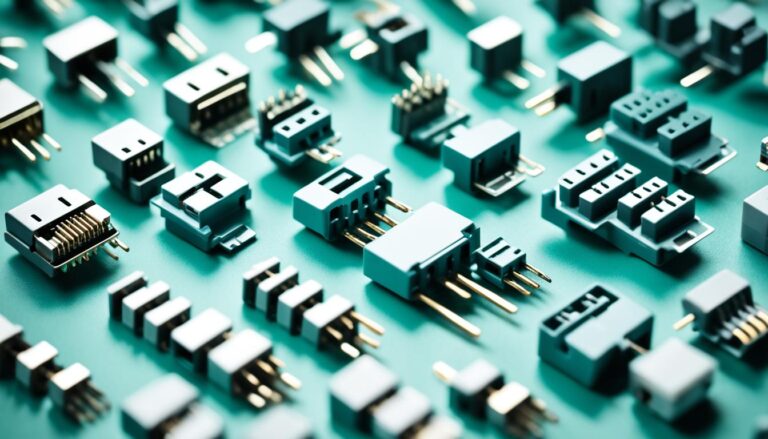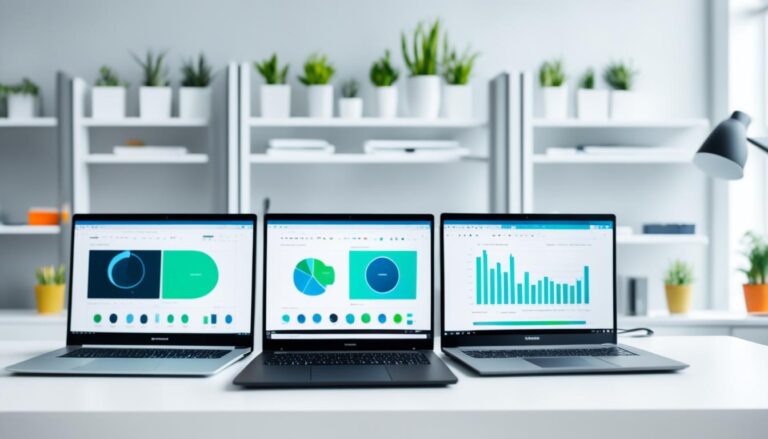Welcome to our guide on display cables and their uses. Technology keeps changing, and so do monitor cables. They help connect your devices and make your viewing better by transferring high-quality audio and video. They can also power devices and support cool features.
We’ll look at the different display cables. We’ll see what makes them useful and how they are used.
HDMI – Audio and Video Transmission
HDMI cables are the top pick for audio and video in many devices. They connect your TV, monitor, game console, or DVD/Blu-Ray player. This gives a smooth experience for both audio and video signals.
HDMI cables support high-res digital content. This means you get to enjoy crystal-clear pictures and immersive audio. Whether it’s movies, games, or design work, HDMI has you covered.
There are different sizes of HDMI cables. Standard ones are for TVs and big monitors. Mini HDMI cables fit smaller gadgets like cameras and portable projectors.
HDMI cables have been the main choice for more than ten years. Their wide use and support by modern devices show their reliability. They’re easy to use and deliver top-notch audio and video.
“HDMI cables provide a seamless experience for transmitting both audio and video signals.”
– TechGuru Magazine
Benefits of HDMI Cables:
- Transmit both audio and video signals
- Support high-resolution digital content
- Available in standard and mini sizes
- Widely adopted and supported by modern devices
| HDMI Cable Specifications | |
|---|---|
| Maximum Resolution | Up to 4K Ultra HD |
| Audio Support | Multi-channel, including Dolby Atmos and DTS:X |
| Bandwidth | 18.0 Gbps (Standard HDMI), 48 Gbps (HDMI 2.1) |
| Connector Type | Standard HDMI Type A, Mini HDMI Type C |
| Compatibility | Compatible with most TVs, monitors, game consoles, and DVD/Blu-Ray players |
DisplayPort – High-Bandwidth Audio and Video Transmission
DisplayPort cables are often seen with desktop monitors. They have more bandwidth than HDMI. This makes them a top choice for gamers who want an amazing gaming experience. You can also find mini versions for laptops.
DisplayPort cable is perfect for those needing smooth audio and video. It suits gaming fans, creatives, or anyone who wants top-notch visuals. It offers excellent performance for all.
It supports many resolutions, including HD and 4K. You get clear visuals and detailed images for games, movie watching, or hefty graphic work.
DisplayPort carries audio and video in one cable. This cuts down the need for many cables. Your workspace stays tidy and organised.
Gamers love DisplayPort for its high frame rates and great image quality. It offers smooth gameplay, less input lag, and a better gaming experience.
Mini versions of DisplayPort cables are great for laptops. They connect easily to external monitors. This is handy for pros who work while travelling.
In summary, DisplayPort cables are top-notch for audio and video. They’re loved by gamers and professionals. If you want excellent gaming or crisp work visuals, DisplayPort is the way to go.
DVI – Video-Only Cable for Older Monitors
DVI cables are often found with older tech, like monitors and graphics cards. They handle digital video well, with DVI-D and DVI-I types around. Once, mini and micro versions were also out there.
If your old monitor lacks HDMI or DisplayPort, a DVI cable works well. These cables are reliable and match well with older technology.
“DVI cables are good for older monitors needing just video. They ensure a steady link with older graphics cards and screens.”
DVI cables are great at sending high-quality video. They’re perfect when you don’t need to send sound.
Advantages of DVI cables:
- They support crisp video signals.
- They work with older tech well.
- You don’t need extra gadgets or adapters.
It’s key to remember, DVI cables don’t carry sound. If you also want sound, you might look at HDMI or DisplayPort.
To sum up, DVI cables are ace for old tech needing just video. They’re known for their solid performance and compatibility. They’re a hit for those with old devices.
Next, let’s check out VGA cables. They’re another old-school choice for video on older screens.
VGA – Analog Video-Only Cable for Older Monitors
VGA cables, also known as analog video cables, were a big deal in the early ’90s. But, as technology got better, we started using new types of cables. Now, VGA cables are mostly seen with old monitors that don’t have ports for HDMI or DisplayPort.
Unlike HDMI or DisplayPort, VGA can only send video signals. They can’t carry audio or other data. Plus, VGA cables don’t perform as well in terms of resolution and refresh rate.
Today, we don’t use VGA cables much for new devices. They don’t fit well with displays needing high resolution, quick refresh rates, or audio. Their popularity has gone down a lot.
Still, VGA cables can be useful. They help connect old gear or for fixing problems. If your monitor only takes VGA, check if your computer has a VGA port. You might need an adapter to link up new tech with a VGA slot.
<!–
| Resolution | Refresh Rate | Audio Support |
|---|---|---|
| 640×480 | 60Hz | No |
| 800×600 | 60Hz | No |
| 1024×768 | 60Hz | No |
–>
VGA Cable Specifications:
- Video-only transmission
- Analog technology
- Lower resolution and refresh rate capabilities
- Commonly found on older monitors
“While VGA cables have become outdated, they still serve a purpose for older equipment or specific scenarios. However, for optimal performance and compatibility with modern displays, it is recommended to upgrade to newer cable types like HDMI or DisplayPort.”
USB-C – Versatile Cable for Audio, Video, and Data Transmission
The USB-C cable stands out for its versatility. It’s not just for charging. People use it for laptops and smartphones too. It’s also perfect for audio, video, and data in monitors.
USB-C cables handle audio and video smoothly thanks to DisplayPort Alt Mode. You can link a USB-C device, like a laptop or phone, with a monitor. Then, you get to enjoy great audio and video quality.
USB-C is brilliant at moving data. You can transfer files, sync up devices, or hook up peripherals swiftly. Thanks to USB 3.1, it’s both quick and effective, making your work easier.
These cables can also carry power. You can connect your laptop to a monitor and charge it simultaneously. This is perfect for staying mobile or keeping your desk tidy.
They even power portable USB-C monitors. You won’t need extra cables. This feature is great for those always on the move or using an extra monitor.
USB-C cables are ideal for many tasks. Whether you’re connecting to a monitor, moving files fast, or wanting fewer cables, they work great. They handle audio, video, data, and power brilliantly, making any setup easy.
Thunderbolt – High-Bandwidth Cable for Audio, Video, and Data Transmission
Thunderbolt cables are for high-bandwidth use in audio, video, and data. Initially, they were only for Intel systems. Now, they work with many devices. Thunderbolt 1 and 2 use mini DisplayPort connectors. But Thunderbolt 3 and 4 use USB-C.
Thunderbolt cables can do a lot at once. They send audio, video, and data together. With their high bandwidth, Thunderbolt cables make multimedia tasks smooth.
Benefits of Thunderbolt Cables:
- High Bandwidth: These cables make data transfer quick and efficient. They ensure steady streaming and fast file sharing.
- Audio and Video Transmission: Thunderbolt cables deliver clear sound and sharp video. This makes multimedia experiences better.
- Support for Data Transmission: Besides audio and video, these cables are great for quick data sharing. They’re useful in professional spaces where moving big files fast is important.
- Compatibility: Many devices work with Thunderbolt cables. This makes connecting devices easy and boosts productivity.
To show you what Thunderbolt cables can do, here’s a table comparing them with other cables:
| Cable Type | Audio Transmission | Video Transmission | Data Transmission | Compatibility |
|---|---|---|---|---|
| Thunderbolt | ✓ | ✓ | ✓ | Wide compatibility with various devices |
| HDMI | ✓ | ✓ | ✗ | Commonly used in consumer electronics |
| DisplayPort | ✓ | ✓ | ✗ | Popular among gamers and desktop users |
| DVI | ✗ | ✓ | ✗ | Primarily for video transmission |
| VGA | ✗ | ✓ | ✗ | Commonly used with older monitors |
| USB-C | ✓ | ✓ | ✓ | High versatility and power delivery capabilities |
“Thunderbolt cables offer exceptional versatility, allowing for the transmission of audio, video, and data signals simultaneously.”
The table shows Thunderbolt cables are top-notch. They handle audio, video, and data well. Their broad device support makes them a top choice for connection needs.
Conclusion
Choosing the right display cable is key to improving how you see things on your screen. This guide has shown different types of cables and what they do best. For gaming, HDMI 2.1 and DisplayPort cables are top picks. They handle fast action and super-clear pictures well.
For work tasks, modern HDMI and DisplayPort cables are great. They give top-notch picture quality and can show very fine details. It’s important to pick a cable that fits your screen and device well for the best results.
Think about what your device needs, the quality of the picture you want, and any special features. Also, choosing the latest cables can help make your setup last longer. By picking the right cable with this guide’s help, you can greatly improve how you view content and enjoy your screen’s full abilities.
FAQ
What are the different types of display cables and their uses?
There are many types of display cables like HDMI, DisplayPort, DVI, VGA, USB-C, and Thunderbolt. These are essential for transmitting audio and video. They also support power delivery and advanced features, such as connecting multiple monitors together.
What is an HDMI cable used for?
HDMI cables connect consumer TVs, monitors, consoles, and DVD/Blu-Ray players. They carry both audio and video. This allows them to support high-resolution content.
What is a DisplayPort cable used for?
DisplayPort cables connect mainly to desktop monitors. They have more bandwidth than HDMI. This makes them ideal for gamers who want top-notch video and audio.
What is a DVI cable used for?
DVI cables connect to older monitors, graphics cards, and laptops. They only support digital video signals. They’re mainly used for video transmission.
What is a VGA cable used for?
VGA cables are older and analog. They’re found on older monitors. VGA is for video only, with lower resolution and refresh rates.
What is a USB-C cable used for?
USB-C cables are very versatile. They handle audio, video, data, and power. They’re great for connecting laptops to monitors and minimizing desk mess.
What is a Thunderbolt cable used for?
Thunderbolt cables are high bandwidth. They handle audio, video, and data. Their versatility and device compatibility make them favored by professionals.
How do I choose the right display cable?
The choice of display cable depends on the devices, required bandwidth, resolution, and features. For gaming, HDMI 2.1 and DisplayPort are best for high frame rates and resolutions. For work, modern HDMI and DisplayPort give better visuals. It’s vital to match the cable with the display’s and device’s capabilities.
